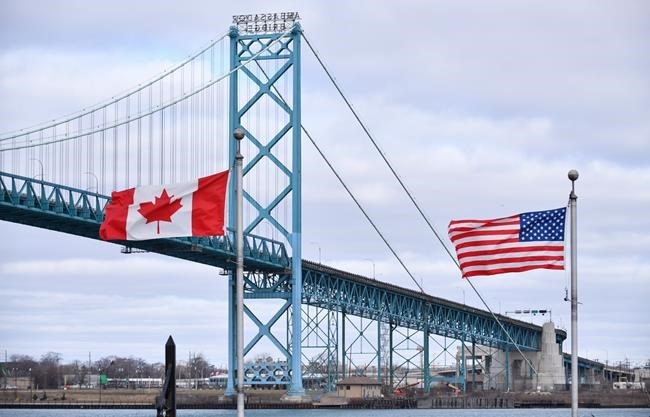WASHINGTON — One year after the North American onset of the COVID-19 pandemic, Canadians remain deeply wary about visitors from the United States despite mounting optimism south of the border, a new poll suggests.
One in seven who took part in the online Léger poll, conducted last week for the Association for Canadian Studies, said they were either very or somewhat worried about allowing cross-border travel.
Only 26 per cent of the 2,200 Canadian respondents said they were either not very worried or not worried at all.
The results from 1,968 Americans who took the survey showed the opposite: 31 per cent were very or somewhat anxious about letting travel resume, with 58 per cent expressing little to no concern.
The research, funded by the Canadian Institute for Health Research for the University of Manitoba and the Canadian-studies association, points to a growing disparity in attitudes between the two countries, said association president Jack Jedwab.
"There remains a sense (in Canada) that Americans are still not mindful of the safety measures and have been less vigilant in that regard than Canadians," Jedwab said.
Recent images of throngs of unmasked Spring Break partiers crowding the streets of Miami Beach, along with states like Texas and Mississippi lifting their COVID-19 restrictions, have only reinforced that impression, he added.
A lingering hangover in Canada after four years of Donald Trump may also be at play, Jedwab said.
"The degree of mistrust during the Trump era will take time to diminish and for trust to be restored."
Incidental, non-essential travel between the two countries has been forbidden for 12 months — a reality that seemed staggering a year ago, but is now widely seen as just one more casualty of COVID-19.
Another 30-day extension of the restrictions, this time through April 21, went largely unnoticed last week when it was quietly confirmed by Ottawa and the U.S. Department of Homeland Security.
That same day, experts from both Canada and the U.S. were gathering over Zoom to take stock of the economic impact of the restrictions and make the case for a bilateral commission to explore how to lift them.
The impact has been especially severe in those U.S. communities near the border, where they depend on Canadian tourism, said Laurie Trautman, director of the Border Policy Research Institute at Western Washington University in Bellingham, Wash.
"As to whether or not these communities can recover to their pre-pandemic levels, I think it's going to be incredibly, incredibly challenging for them," Trautman told the panel.
"If you are looking at a potentially layered approach to easing the restrictions, then you might consider these places and these people that have been really disproportionately impacted, and start there."
The Opposition Conservatives are also pushing the federal government for a comprehensive strategy to reopen the border as part of a broader plan to ease pandemic restrictions across the country.
"We're talking about a safe, data-driven and effective plan to reopening," Conservative Leader Erin O'Toole told a news conference.
"That will include the border, that will include airports, ports — all areas of federal jurisdiction where there should be a national rapid screening and testing process."
Some U.S. lawmakers, too, such as New York congressman Brian Higgins, have been aggressively lobbying the White House to start getting serious about a plan to reopen the border.
Higgins said he wants to see some sort of gradual process, perhaps by expanding the categories of permitted travel to include people who own property on the other side of the border, have loved ones living stateside or need to conduct in-person business meetings with clients.
The Canadian Association of Moldmakers, based in Windsor, Ont., is circulating a petition to press Ottawa to allow members of the region's $31-billion manufacturing industry more latitude in crossing the border.
"Denial of entry and inconsistent application of entry and isolation/quarantine rules at the border are costing these industries millions of dollars in lost revenue — and has and will continue to result in lost opportunities, jobs, economic growth and taxation in Canada," the petition says.
Jedwab said there's a risk that unless some level of discussion gets underway soon, the disparity in public opinion could point to another source of bilateral tension between Canada and the United States.
Trudeau has been so "locked in" to the monthly extensions of the border restrictions that they have become routine, Jedwab said.
He "cannot suddenly turn them around without a process that involves public messaging that describes a plan constructed by health officials on both sides of the border."
A separate online Léger survey conducted earlier this month found very few Canadian respondents would be willing to travel to the U.S. this summer, even if it were an option.
About 40 per cent of those surveyed said they intended to take vacations later this year, but the vast majority said they would either confine their travel to their provinces of residence or some other province in Canada.
Only 12 per cent of those planning vacations said they intended to leave the country.
Online surveys cannot be assigned a margin of error because they do not randomly sample the population.
This report by The Canadian Press was first published March 23, 2021.
James McCarten, The Canadian Press



